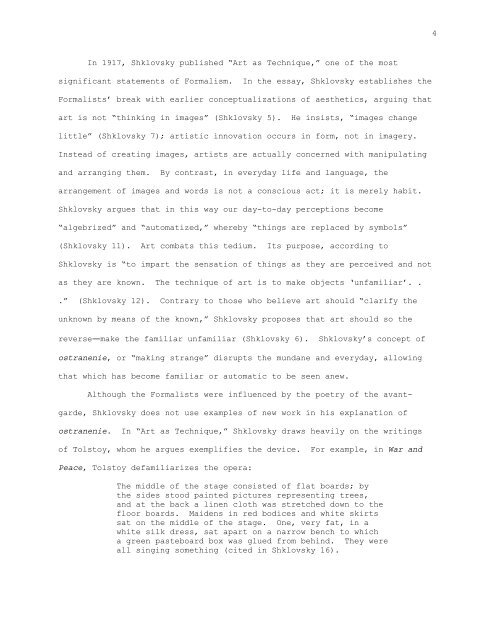Defamiliarization - Audrey Watters
Defamiliarization - Audrey Watters
Defamiliarization - Audrey Watters
You also want an ePaper? Increase the reach of your titles
YUMPU automatically turns print PDFs into web optimized ePapers that Google loves.
In 1917, Shklovsky published “Art as Technique,” one of the most<br />
significant statements of Formalism. In the essay, Shklovsky establishes the<br />
Formalists’ break with earlier conceptualizations of aesthetics, arguing that<br />
art is not “thinking in images” (Shklovsky 5). He insists, “images change<br />
little” (Shklovsky 7); artistic innovation occurs in form, not in imagery.<br />
Instead of creating images, artists are actually concerned with manipulating<br />
and arranging them. By contrast, in everyday life and language, the<br />
arrangement of images and words is not a conscious act; it is merely habit.<br />
Shklovsky argues that in this way our day-to-day perceptions become<br />
“algebrized” and “automatized,” whereby “things are replaced by symbols”<br />
(Shklovsky 11). Art combats this tedium. Its purpose, according to<br />
Shklovsky is “to impart the sensation of things as they are perceived and not<br />
as they are known. The technique of art is to make objects ‘unfamiliar’. .<br />
.” (Shklovsky 12). Contrary to those who believe art should “clarify the<br />
unknown by means of the known,” Shklovsky proposes that art should so the<br />
reverse—make the familiar unfamiliar (Shklovsky 6). Shklovsky’s concept of<br />
ostranenie, or “making strange” disrupts the mundane and everyday, allowing<br />
that which has become familiar or automatic to be seen anew.<br />
Although the Formalists were influenced by the poetry of the avant-<br />
garde, Shklovsky does not use examples of new work in his explanation of<br />
ostranenie. In “Art as Technique,” Shklovsky draws heavily on the writings<br />
of Tolstoy, whom he argues exemplifies the device. For example, in War and<br />
Peace, Tolstoy defamiliarizes the opera:<br />
The middle of the stage consisted of flat boards; by<br />
the sides stood painted pictures representing trees,<br />
and at the back a linen cloth was stretched down to the<br />
floor boards. Maidens in red bodices and white skirts<br />
sat on the middle of the stage. One, very fat, in a<br />
white silk dress, sat apart on a narrow bench to which<br />
a green pasteboard box was glued from behind. They were<br />
all singing something (cited in Shklovsky 16).<br />
4


